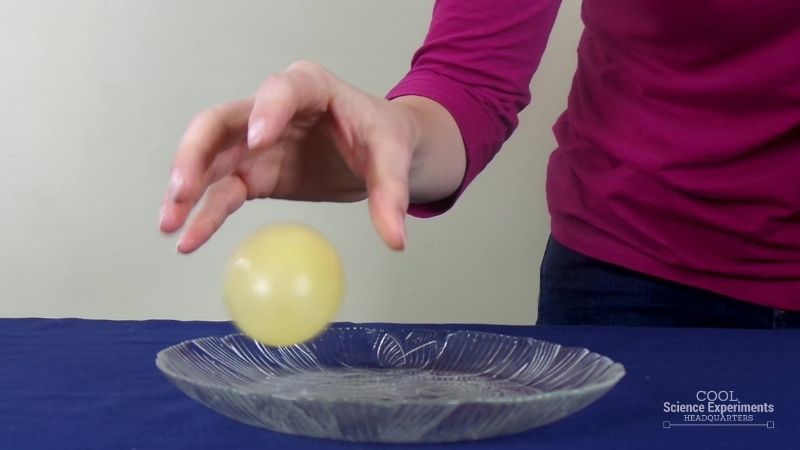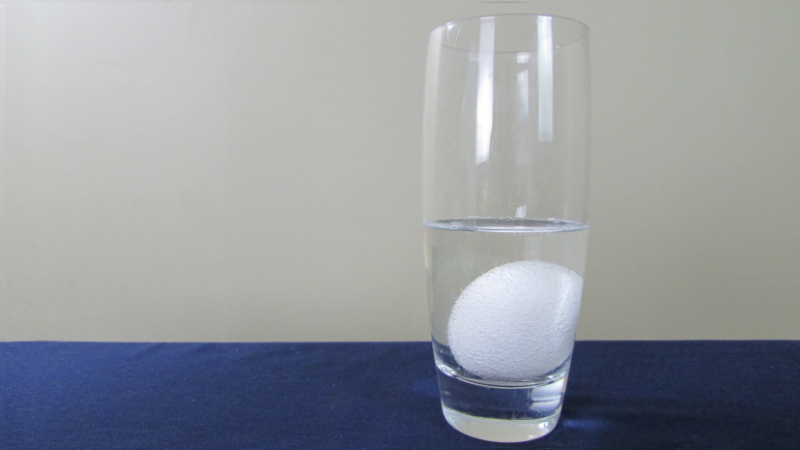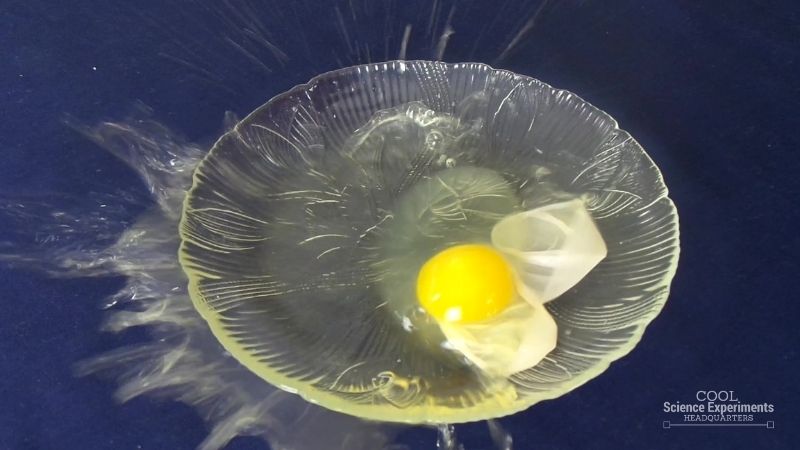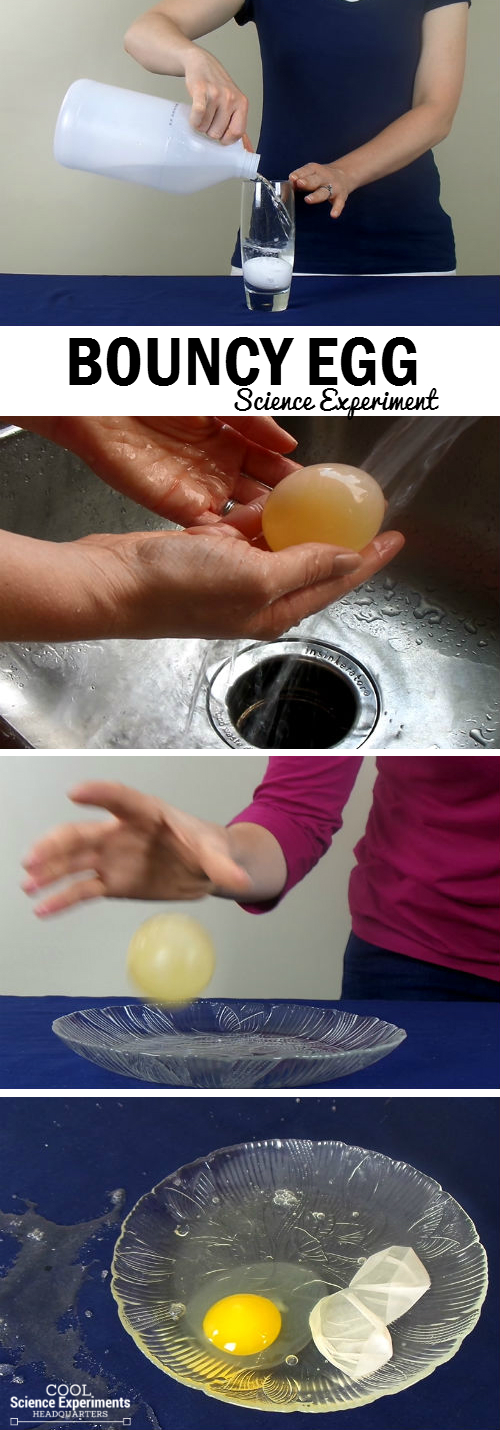Hold on to your eggs because this egg in vinegar science experiment might have your kids bouncing along with these bouncy raw eggs. Kids will discover how a chemical reaction can dissolve what seems solid into something that feels more like a bouncy ball!
Watch the video, print out the instructions, then try it for yourself. Our simple scientific explanation helps kids see and feel the results of chemical reactions while learning how it works.

JUMP TO SECTION: Instructions | Video Tutorial | How it Works
Supplies Needed
- Raw Egg
- Glass or Jar
- Vinegar
Bouncy Egg Science Lab Kit – Only $5
Use our easy Bouncy Egg Science Lab Kit to grab your students’ attention without the stress of planning!
It’s everything you need to make science easy for teachers and fun for students — using inexpensive materials you probably already have in your storage closet!
Egg in Vinegar Science Experiment Instructions
Experiment Setup – Start with some observations about the egg. Explain that it is a raw egg and that that the shell is fragile and can easily be cracked. Demonstrate this with another egg. Then ask some questions. Does it seem possible that we can get the egg to bounce? Next observe the supplies for the experiment. What do you think will happen if you put the egg in vinegar? Write down your hypothesis (prediction) and then follow the steps below.
Step 1 – Get a raw egg and carefully place it into a glass or jar. Then fill the glass with white vinegar until the egg is completely submerged.

Step 2 – Leave the egg in the glass for 2-3 days. Each day, check back on the egg. Make some observations. Do you notice any changes to the egg? Is anything happening to the vinegar? Write down your observations each day. After about 3 days the egg will start to become translucent and you will know it is ready to move to step 3.

Step 3 – Carefully remove the egg from the glass and rinse it under some tap water. While rinsing the egg, gently rub the outside of the egg and the white film will come off leaving you with a translucent egg. Examine the egg and make some observations. Does the egg look different from when you started the experiment? Does the egg feel different? Perhaps you notice that it feels rubbery (like a bouncy ball). Write down your observations.

Step 4 – Over a plate or other container, lift the egg 1-2 inches in the air, let go, and watch it bounce. Make some observations. What happens to the egg? Does it bounce? Is this different than what you expected?

Step 5 – When you are ready for some messy fun, lift the egg a little higher in the air and let it go…SPLAT!
Wondering what caused the egg to bounce? Find out the answer in the how does this experiment work section below.
Video Tutorial
Watch the Bouncy Egg in Vinegar Science Experiment Step by Step Instructions
How Does the Bouncy Egg Science Experiment Work
The egg becomes bouncy as a result of a chemical reaction between the eggshell and the vinegar. The eggshell of a chicken egg is made of calcium carbonate, and vinegar is a weak acid. If you’ve ever mixed baking soda and vinegar together, you know the violent reaction that results. The calcium carbonate that makes up the eggshell will react with the vinegar the same way baking soda reacts with vinegar (just a lot less violently). You know the vinegar and calcium carbonate of the eggshell are reacting because of the small bubbles that form around the egg when it is placed in the vinegar. These small bubbles are carbon dioxide gas, which are the result of the reaction between calcium carbonate and vinegar.
Once the shell of the egg is gone, all that is left covering the egg is a thin membrane. The vinegar begins working on the egg’s membrane. The membrane of a chicken egg is selectively permeable. The vinegar is able to cross the selectively permeable membrane of the egg through osmosis. The vinegar toughens up the membrane of the egg making it bouncy!
The selectively permeable membrane of the egg means that some substances can pass through the membrane while others cannot.
Osmosis is the diffusion of solvent molecules through a selectively permeable membrane.
Bouncy Egg Science Lab Kit – Only $5
Use our easy Bouncy Egg Science Lab Kit to grab your students’ attention without the stress of planning!
It’s everything you need to make science easy for teachers and fun for students — using inexpensive materials you probably already have in your storage closet!
Other Ideas to Try
Try other acids like lemon juice. Does it have the same effect on the eggshell? Try other types of eggs – white vs. brown shells, regular vs. organic eggs, maybe you can even find some unusual egg types at your local grocery store to experiment with (turkey, duck, quail eggs).
I hope you enjoyed the experiment. Here are some printable instructions:

Bouncy Egg Science Experiment
Materials
- Raw Egg
- Glass or Jar
- Vinegar
Instructions
- Get a raw egg and carefully place it into a glass or jar. Then fill the glass with white vinegar until the egg is completely submerged.
- Leave the egg in the glass for 2-3 days. Each day, check back on the egg. Make some observations. Do you notice any changes to the egg? Is anything happening to the vinegar? Write down your observations each day. After about 3 days the egg will start to become translucent and you will know it is ready to move to step 3.
- Carefully remove the egg from the glass and rinse it under some tap water. While rinsing the egg, gently rub the outside of the egg and the white film will come off leaving you with a translucent egg. Examine the egg and make some observations. Does the egg look different from when you started the experiment? Does the egg feel different? Perhaps you notice that it feels rubbery (like a bouncy ball). Write down your observations.
- Over a plate or other container, lift the egg 1-2 inches in the air, let go, and watch it bounce. Make some observations. What happens to the egg? Does it bounce? Is this different than what you expected?
- When you are ready for some messy fun, lift the egg a little higher in the air and let it go…SPLAT!




this website was extremely helpful
Nice ..
How long should I wait accurately to turn the egg bouncy
You need to wait at a minimum of two days before bouncing the egg.
Hi you have to wait for a maximum of 1-3 days till it bounces.
1 Day only
Ours took about 3days. But I decided to take the first egg out on day 2(it was already see through),rinse the egg, and re-submerge it in fresh vinegar.
thank you for this useful information guys. always fun to get my hands messy and do a science experiment with with reuban and max 🙂
my daughter did this for her science fair project and she left it in for 24 hours and it was perfect
We think the calicium on the egg shell dissolves with the vinegar which is an acid.
Are we correct?
This is so cool.
Thanks! It helped me a lot for my science project at school!
Can you add food colouring? ??
Yes you can, when i did this experiment in class we did food coloring and highlighter and we made glow in the dark and colored eggs.
The acid from the vinegar made the elasticity in the egg.
the eggshell combined with the vinegar and made a bouncy egg